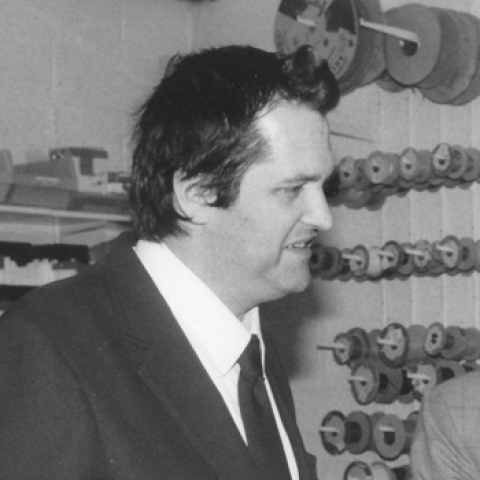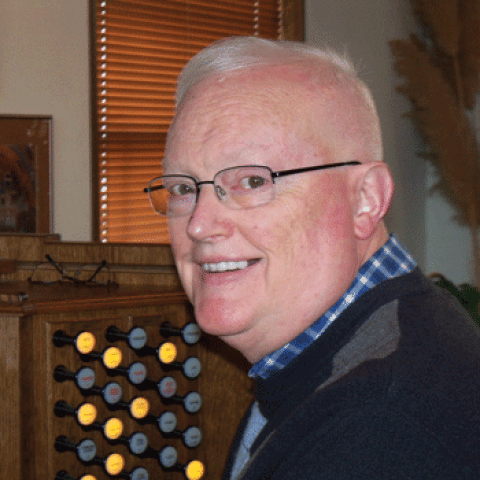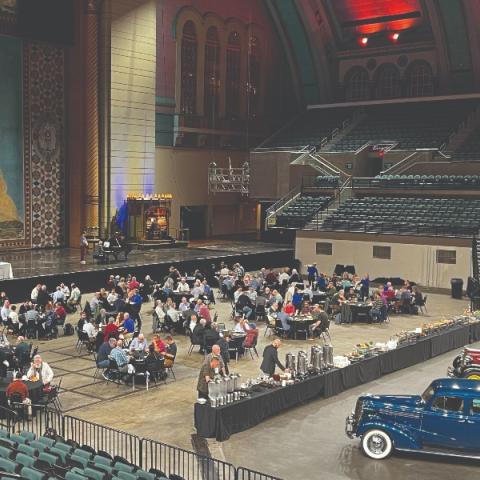
Franklin Ashdown
Franklin Ashdown, physician, organist, and composer, died January 30 in El Paso, Texas. Born May 2, 1942, in Logan, Utah, he started playing the piano at an early age and was called to be the organist for his ward of The Church of Jesus Christ of Latter-day Saints at age 13. After his family moved to Lubbock, Texas, he began organ studies with Judson Maynard. He completed his undergraduate work at Texas Tech University in Lubbock, where he sang in the concert choir. Pursuing his passion for medicine, he attended Southwestern Medical School of the University of Texas in Dallas. He was in Parkland Memorial Hospital in Dallas when President John F. Kennedy was shot and brought into the emergency room, where Ashdown was recruited to be a liaison between reporters and doctors.
Ashdown spent his medical residency in Salt Lake City, and he spoke later of the great influence Tabernacle Organist Alexander Schreiner had on him. He felt that the signature sound of the Tabernacle organ and the sonorities Schreiner was able to exploit in his improvisations greatly affected his writing. Ashdown also studied organ in Utah with James Drake, who encouraged him to begin composing.
This was also the time of the Vietnam War, and Ashdown was able to defer being drafted until he completed his medical training. In order to fulfill his military obligations, he was assigned as a doctor to Holloman Air Force Base in Alamogordo, New Mexico, in 1971. He started his own medical practice as an internist in 1973, serving as physician in Alamogordo until his retirement in 2008.
For many years Ashdown was organist and choir director at The Church of Jesus Christ of Latter-day Saints in Alamogordo. Even during his busy medical years, he was composing. Upon his retirement, he was able to focus his full-time attention on composing organ and choral works. His organ works include many hymn and folk tune arrangements and also numerous original concert works. Over his career he had published more than 250 pieces for solo organ, at least 30 collections of organ music, 15 works for organ with other instruments, and 50 choral works with Augsburg Fortress, Concordia Publishing House, Gentry Publications, GIA Publications, H. W. Gray, Wayne Leupold Editions, Lorenz, MorningStar Music Publishers, Neil Kjos Co., Oregon Catholic Press, The Organist’s Companion, Oxford University Press, Paraclete Press, Sacred Music Press, and Zimbel Press.
His works were performed in venues such as Grace Cathedral, San Francisco; The Tabernacle at Temple Square, Salt Lake City; St. Paul’s Cathedral, London; and Notre Dame Cathedral, Paris. They have also been featured on American Public Radio’s Pipedreams, National Public Radio’s All Things Considered, and the Tabernacle Choir’s weekly broadcast Music and the Spoken Word.
Franklin Ashdown is survived by six siblings as well as 27 nieces and nephews and 101 great-nieces and nephews. Services were held February 4 at The Church of Jesus Christ of Latter-day Saints, Alamogordo.
Margo Halsted
Margo Halsted died February 22. Born Margo Armbruster on April 24, 1938, in Bakersfield, California, she was first introduced to the carillon as an undergraduate student at Stanford University. From Stanford she earned a bachelor’s degree in music (1960) and a master’s degree in education (1965). In 1975 she earned a Master of Music degree from the University of California Riverside. Halsted passed the Guild of Carillonneurs in North America (GCNA) carillonneur examination at the 1967 congress in Ottawa, Canada, and earned a diploma from the Netherlands Carillon School, Amersfoort, in 1981. She was active within the GCNA over many years, serving as assistant secretary, a member of the board of directors, chair of several committees, and editor of the guild’s newsletter. Halsted was awarded honorary membership in the GCNA and twice received the GCNA’s Certificate for Exceptional Service. She was also awarded the University of California Berkeley Medal, Bell and Citation Awards from the World Carillon Federation, and was an honorary member of the Belgian Carillon School, Mechelen.
Over the course of her career, Halsted served as associate carillonneur for Stanford University, 1967–1977; lecturer, university organist, and carillonist for University of California Riverside, 1977–1987; assistant professor and later associate professor at the University of Michigan, 1987–2003; with additional service at Michigan State University and University of California Santa Barbara, teaching more than 200 students to play the carillon. At the University of Michigan, Ann Arbor, she taught and performed on the university’s two carillons in the only master’s degree program for carillon in the United States. She was named Associate Professor Emerita in 2003.
Halsted concertized around the world, consulted for carillon projects in the United States and abroad, and lectured/presented at five World Carillon Federation conventions. She composed music for the carillon and published numerous articles about the instrument and served as contributing editor for the carillon for The Diapason from 1981 until 1991.
Margo Halsted was preceded in death by two weeks by her husband Peter LeSourd. Memorial gifts for may be made to the Armbruster Fund, an endowment that she started to benefit the University of Michigan’s carillon program (https://donate.umich.edu/XVjKB).
Jan Reagan Rowland
Jan Reagan Rowland died January 18 in Houston, Texas. He was born in Beaumont, Texas, in 1944, attended local schools there, and enrolled at Lamar University in Beaumont, where he studied electrical engineering and enrolled in German language classes. He completed two years of study before being called into the United States Army and serving from 1966 to 1968, where his expertise in speaking German earned him an assignment in Munich, Germany. It was there that he met his future wife, Hanne, and they were married in Berlin in 1969.
As his tour of duty in the army was nearing its end, the United States representative for E. F. Walcker & Cie. of Ludwigsburg, Germany, suggested that Rowland take a job at Walcker so that he could become more useful as a skilled organ installer once he returned to the United States. Rowland worked at Walcker for 35 days in July and August of 1968, then returned to the United States, where two Walcker jobs awaited installation: one in Michigan, the other at Colby College, Waterville, Maine. While in Waterville, Rowland learned of another installation happening at the First Congregational Church in the same town and made a visit to the church, where he met David W. Cogswell, the owner/president of Berkshire Organ Company. Cogswell telephoned Rowland early in 1969 with an offer of a job as factory manager of Berkshire, which Rowland accepted, and within a couple of months he was named executive vice president.
Discussions between Rowland, Cogswell, and others about the costs of travel to Europe to meet with organbuilders germinated the idea of an organization of organ building individuals, not companies, and resulted in a convention with no title in Washington, D.C. That gathering in 1973 became the founding of the American Institute of Organbuilders. As an attendee of that convention, Rowland was considered a co-founder of the organization and was designated a charter member.
Later in 1973, concerned about the slow growth of the Berkshire Organ Company, Rowland decided to form his own company with Pieter Visser, who was hired by Berkshire only four months earlier. Houston, Texas, was chosen as the site for the new company, Visser-Rowland Associates.
The company grew as Houston expanded in the 1970s and 1980s, with oil companies creating more jobs and with more churches being built. For the next eleven years, Visser-Rowland built dozens of pipe organs for sites from Maine to California. One of the last instruments before Rowland’s retirement from the firm was built for Bates Recital Hall at the University of Texas at Austin. At the time, it was the largest mechanical-action organ pipe organ built by a United States firm, having 67 stops.
Rowland was accepted into membership of the International Society of Organ Builders in 1984, and he became a member of the editorial board of the society’s information trade journal, for which he wrote articles on various organbuilding techniques. He often translated articles and speeches of other organbuilders from German into English. He was invited to Europe over two dozen times to the annual International Society of Organbuilders congresses due to his expertise.
In 1984 Rowland started his own shop producing custom drawknobs for many organbuilders in America, Europe, and Japan. However, his real enjoyment came from designing and building special tools and machines for different organbuilders, tools and machines that could not be bought elsewhere.
Rowland was perhaps best known for his intelligence and ability to imagine, invent, and make things work better and more efficiently. He was internationally respected for his designing of a computerized lathe for completing tasks such as shaping drawknobs for pipe organs. This enabled pipe organ builders to cut costs enormously by reducing labor and time, making tens of thousands of hours of tedium and templates obsolete through his inventions. Rowland constructed some of these computerized systems for pipe organ companies in Europe, filling the cargo hold on a plane to ship the devices overseas.
Rowland enjoyed attending the American Institute of Organbuilders convention every year with his wife, Hanne. He was proud that the AIO stayed in business and attracted and taught organbuilders to help each other and keep organbuilding an interesting and unusual business.
Jan Reagan Rowland is survived by Hanne, his wife of 54 years, of Houston, and a sister Karen Rowland Richardson and her husband Ronnie of Beaumont, Texas. A military burial with full honors was held at the Houston National Cemetery on January 30.
—Hanne Rowland
Karen Rowland Richardson
Christopher Lavoie






